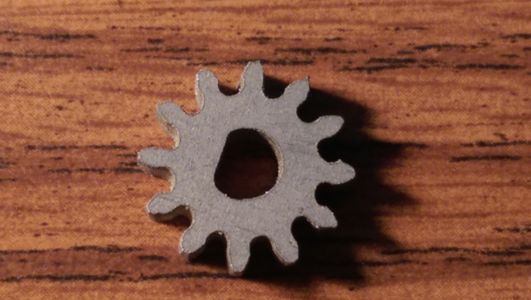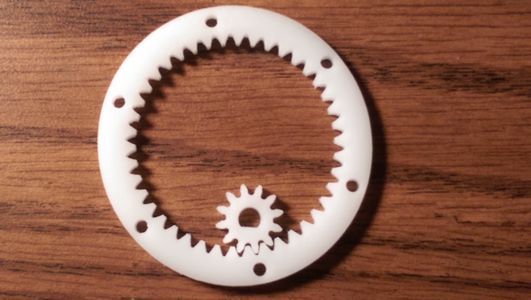RC15Motors&Gears
The robots for the 2015 RoboCup SSL competition utilize new 50 Watt brushless motors from Maxon Motors. The previous two fleets of robots designed and built by the teams used 30 Watt motors, also from Maxon.
Background
2008 Robot Fleet
The 2008 fleet of robots utilize a 30W Maxon Motor. Power was transmitted through a spur gear fixed to the shaft. This spur gear is held in place by a set screw that was set onto a flat grinded onto the shaft. There are no encoders on these robots.
Performance
These motors perform fine to this day (several years later). However, the lack of encoders makes it difficult to control the robots with any degree of precision.
2011 Robot Fleet
The 2011 fleet of robots utilize the same 30W Maxon Motor. Power was transmitted through a spur gear built into the motor shaft. The custom shafts were outsourced, and were effectively pinion wire that was turned down on a lathe to have appropriate sizing for:
- Pressing the shaft into the brushless motor shell
- Pressing an encoder wheel onto the end of the shaft
- Terminating the shaft such that the encoder housing could be capped and kept undisturbed from outside elements
Performance
These motors perform extremely poorly due to the in-house manipulation. Due to errors during the team's manufacturing process in previous years, the brushless motor shell can slip on the custom shaft (i.e. the press fit is not strong enough to prevent slip), thereby degrading power transmission. This was rectified to an extent by epoxying the shaft onto the shell. However, this process is messy, inconsistent and sometimes results in deformation of components when assembled, thereby degrading the motors even further.
The 2011 robots suffer from hall faults due the misalignment of components, and the fleet is largely unusable due to these problems. However, the encoders do prove to be useful if the robot has little to no motor issues.
Requirements
The motors and drive gears of the 2015 robot fleet is intended combine the good aspects of both the 2008 and 2011 fleets, without any of the problems. These requirements are as follows:
Primary requirements
- The team should not have to disassemble the motors in order to assemble the drivetrain. (The 2011 robots required a custom shaft, which required pressing combing apart and then reassembling. This results in degraded performance due to a variety of issues).
- No epoxy to be used anywhere in the process
- Any motor shaft manipulation should be able to be done safely and easily on in-house equipment
- Compact design following that of the 2011 robots, as the large 50W motors do not permit such broad drive module as seen in the 2008 fleet.
Secondary requirements
- The gears for the drivetrain are manufactured in-house on either the laser cutter, waterjet cutter, or injection molding machine
Motor Specifications
The 2015 fleet uses new 50W Maxon motors for the drivetrain. In order to utilize these motors, some modifications were done to them.
Modifications by Manufacturer
A set of modification were done by the manufacture by the teams request:
- Decreased wire length. The length of the wires was requested to be 6 inches. This length is sufficient (with extra) for wire routing from the bottom plate to the connectors. If some of the wire is left, it can be easliy clamped together. The reason long wires were not advisable is because the electrical team would need to cut them and cramp them (with much less quality than the factory is capable of).
- Decreased shaft length. The shaft length of the motor was decreased to fir the design. The shaft was accustomed to the first draft of the drivetrain plates. However, if the new shaft does not fit properly, the driveplate thickness would be changed to have the shaft stick out more or less.
- Added flat. A flat was added to the shaft on one side alon the whole length. This shaft is required to hold the motor gear from slipping on the shaft.
Modifications by Team
One modification to the motors was done by the team:
- A groove. This groove is designed to hold a shaft collar, which will keep the motor gear in place.
Testing and Prototyping
Waterjet
The two main materials cut via the waterjet have been aluminum 6061 and mild steel. Because of the nature of the waterjet process, parts are often produced with taper. When trying to achieve flat gear teeth, this is undesirable. Below are tests we ran to understand the taper produced by the process and account for it.
For these materials, we modeled a 1"x2" rectangle and cut it out to determine understand the tolerances of the waterjet process. By understanding the taper produced by the waterjet, we could account for that by using the tilting capability of the waterjet. The results are below.
Steel
Thickness - 0.117"
| Trial 1 |
Trial 2 |
Zero-Taper Attempt | |
| Waterjet set thickness |
0.117" | 0.130" | 0.117" |
| Taper compensation? (Yes/No) |
No | No | Yes |
| Estimated time to cut (minutes) |
0.583 | 0.636 | 0.938 |
| Measured dimension on top (Nominal 1") |
0.9937 | 0.9877 | 0.9945 |
| Measured dimension on bottom (Nominal 1") |
1.0016 | 1.0002 | 0.9931 |
| Resulting Taper (degrees) |
1.93 |
6.25 | 0.342 |
As can be seen, through some basic computation, we were able to significantly reduce the draft encountered in the waterjet process.
Estimated time for cutting one of the motor gears: 1.6 minutes
Aluminum
Thickness - 0.125" thick
| Trial 1 | Trial 2 | |
| Waterjet set thickness | ||
| Taper compensation? (Yes/No) | ||
| Estimated time to cut (minutes) | ||
| Measured dimension on top (Nominal 1") | ||
| Measured dimension on bottom (Nominal 1") | ||
| Resulting Taper (degrees) |
Laser Cutter
Laser cutters are great machines for cutting a variety of materials, primarily plastics and woods. The minimal setup and overhead, as well as the cleanliness of the process makes it a more preferred process when compared to the waterjet or mill. However, metals cannot be cut on this machine - only metal marked with a marking compound.
Specifically, we have access to a variety of laser cutters on campus. The most common ones that we use are Trotec Speedy 300 laser cutters (http://www.troteclaser.com/en-US/Laser-Machines/Mid-Size/Pages/Speedy300.aspx). There is 1 machine at the MRDC that is 45 Watts, and 2 more that are 120 Watts.
Delrin/Acetal
Our primary material to laser cut was delrin. Delrin exhibits nice properties in terms of strength and smoothness. It also cuts nicely on the laser when the proper settings are determined.
- Special care should be taken when cutting delrin. The cutting process produces formaldehyde gas. Additionally, the material burns with a fairly colorless flame.
Cut Settings
In short, we did several (25) high power, slow passes in etch mode on the laser. This was followed up with 2 cut passes at a relatively low speed. Below are the settings we used to cut the delrin gears with reasonable accuracy.
| Etch/Cut? |
Etch |
| Line Thickness |
0.001" |
| Power |
90 |
| Speed | 4.5 |
| PPI/Hz | 1000 |
| Passes | 25 |
| Lens (Black/Red/Blue) | Black |
This was followed by a cut at the following settings:
| Etch/Cut? | Cut |
| Line Thickness | Vector |
| Power | 90 |
| Speed | 6 |
| PPI/Hz | 1000 |
| Passes | 2 |
| Lens (Black/Red/Blue | Black |
It is likely very possible to cut the gears without as many passes. We hypothesize that increasing the PPI/Hz may help to fully cut all edges of the material so that it is fully removed without the final 2 cut passes.

